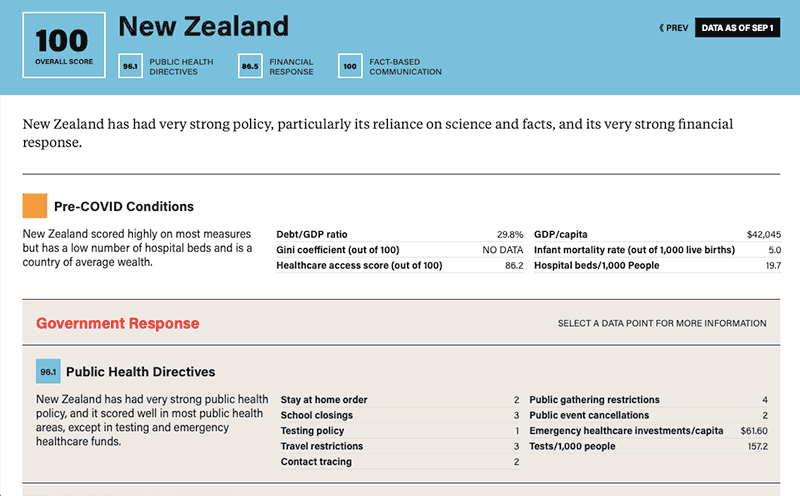Despite indifferent lockdowns and poor testing, Japan seems to be skipping the worst of the pandemic.
Japan
- Data as of Aug 1
- Next 》
- 40.2 Public Health
Directives - 100 Financial
Response - 100 Fact-Based
Communication
- 40.2 Public Health
Directives - 100 Financial
Response - 100 Fact-Based
Communication
Japan has a strong overall score, driven by its generous financial response and a reliance on facts, although its public health policy is very weak.
Pre-COVID Conditions
Despite being among the most heavily indebted countries in the Index, Japan’s healthcare system is very strong, contributing to its relatively strong score.
- Debt/GDP ratio 237.1%
- GDP/capita $46,827
- Gini coefficient (out of 100) 32.9
- Infant mortality rate (out of 1,000 live births) 2
- Healthcare access score (out of 100) 89
- Hospital beds/1,000 People 97.1
Government Response
Select a data point for more information(Data points represent policy level as of Aug 1.)
Public Health Directives
Japan scored near the median on public health policy, with strong scores on school closings and travel restrictions countered by a weak stay-at-home order, and limited testing.
- Stay at home order 1
- Public gathering restrictions 0
- School closings 1
- Public event cancellations 1
- Testing policy 2
- Emergency healthcare investments/capita $138.37
- Travel restrictions 3
- Tests/1,000 people 0.1
- Contact tracing 1
Financial Response
Japan has a very strong score on its financial response, with the highest stimulus and debt relief in the Index, although its income support for workers is poor.
- Financial stimulus as share of GDP 42.2%
- Income support 1
- Debt forebearance 2
Fact-Based Communication
Japan’s government is very strong in this category as it has not engaged in misinformation or limited press freedom in response to COVID-19.
- Reliance on science/fact based information 0
- Press freedom 0
COVID-19 Status as of Aug 1
Japan has one of the highest scores in this category, led by case and death rates that are the lowest in the Index, and a low positivity rate, although its low public health policy score and median change in positivity rate mean that these numbers could rise rapidly if conditions change.
- Total deaths 1,006
- Death rate per 100K 8
- Total cases 34,372
- Cases per 100K 272
- Percent of positive tests 3.6
| Date | Status | New Cases/1M | |
|---|---|---|---|
| 1 | May 25 | State of emergency is lifted everywhere | 0.31 |
| 2 | Jul 15 | Rise in cases leads to requests to limit traveling outside Tokyo, and going to karaoke clubs or bars, until the end of August | 2.64 |
Differentiating Factors
- Social messaging, not strict enforcement, sees success: Japan's post-WWII constitution constrains the ability of the government to impose laws on the population unilaterally, with the result that adherence to lockdown and social distancing policies is entirely voluntary. Despite this, authorities in Tokyo reported a 70-80 percent reduction in social interaction through social messaging and early evening closure of restaurants. Read More
- Generous support for workers and businesses: In early April the government announced a $1.1 trillion emergency economic package, three quarters of which was directed to employment and business support, and much of the rest working to strengthen the healthcare system. Read More
- Young people experience second wave: Despite Japan's early success, its re-opening has led to an increase in cases linked to clubs and nightlife. An estimated 70 percent of Japan's new diagnoses in June were among people in their 20s and 30s. Read More
Compared with Other Island Nations
-
58Iceland 1,885
Cases 5,524
Per 1M 10
DeathsIceland has a very strong score, owing heavily to its reliance on facts as well as generous debt and income support; its large improvement since January was keyed by significant improvements in public health policy and financial support.
-
72Indonesia 108,376
Cases 396
Per 1M 5,131
DeathsIndonesia scores relatively weakly, a big drop in the past few months, keyed by substantial weakening of travel restrictions, testing policy, and debt relief.
-
100New Zealand 1,212
Cases 251
Per 1M 22
DeathsNew Zealand has had very strong policy, particularly with regard to its reliance on science and facts and its relatively strong financial response.
-
60Taiwan 474
Cases 20
Per 1M 7
DeathsTaiwan has a relatively strong policy score, but its minimal stimulus and weak debt relief bring it down. However, the data does not accurately measure its advanced contact tracing, which may have diminished the need for more restrictions; this likely results in a score that underestimates Taiwan’s response.
Further Reading From Foreign Policy
Be the source of actionable insight.
Select one of the subscription options below to read the full Covid-19 Global Response Index. Unlock even more global intelligence with a subscription to FP Insider.
Already an FP Insider? Log In
Looking for group access? Contact us directly

Statistics and government response factors available on each country profile include:
Pre-COVID Conditions:
- Debt to GDP ratio
- Infant mortality rates
- Hospital beds per 1,000 people
- Gini coefficients measuring inequality
- Health access and quality
COVID-19 Public Health Directives:
- Stay-at home orders
- School-closing policy
- Public-gathering restrictions
- Cancellation of public events
- Testing policy and rates per 1,000 people
- Emergency healthcare spending per capita
- Travel restrictions
- Contact tracing
COVID-19 Financial Response:
- Stimulus package as a share of GDP
- Income support
- Debt-forbearance
Public Communications:
- Instances of misinformation by leadership
- Limitations on press freedom, censorship
Current/Historic In-Country COVID-19 Status:
- Death rates per 1 million
- Case rates per 1 million





